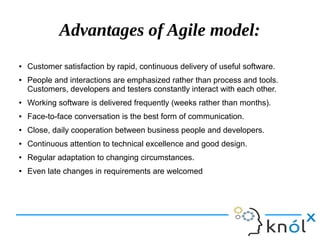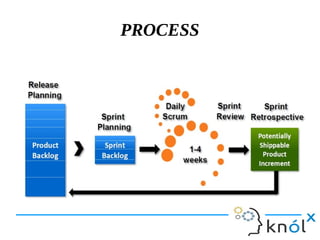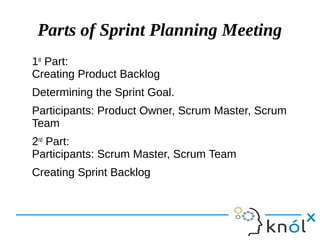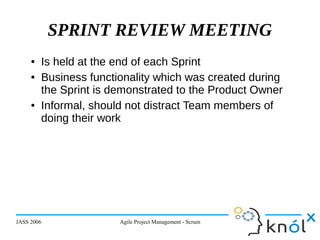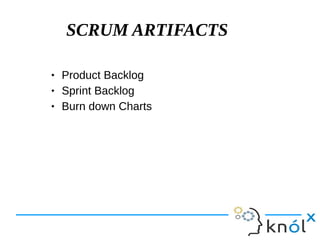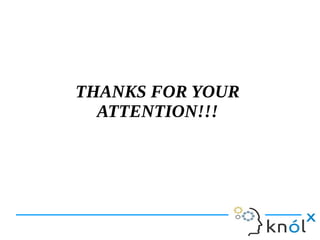Introduction To Agile
- 1. Swati Rao Knoldus Software LLP Introduction To AGILE
- 2. Discussion Points ● History ● What is Agile ● How does it works ● Why we use Agile Methods ● Agile Manifesto ● Agile Methodologies ● Scrum
- 3. History ● In 2001, this new management paradigm began to pick up momentum, agile was formalized when 17 pioneers of the agile methodology met at the Snowbird Ski Resort in Utah and issued the Agile Manifesto. 1.Kent Beck 2.Mike Beedle 3. Arie van Bennekum 4. Alistair Cockburn 5.Ward Cunningham 6.Martin Fowler 7.James Grenning 8.Jim Highsmith 9.Andrew Hunt 10.Ron Jeffries 11.Jon Kern 12.Brian Marick 13.Robert C. Martin 14.Steve Mellor 15.Ken Schwaber 16.Jeff Sutherland 17.Dave Thomas
- 4. What is Agile? ● Agile is a time boxed, iterative approach to software delivery that builds software incrementally from the start of the project, instead of trying to deliver it all at once near the end. ● It works by breaking projects down into little bits of user functionality called user stories, prioritizing them, and then continuously delivering them in short two week cycles called iterations.
- 5. How does it work? You make a list: ● Sitting down with your customer you make a list of features they would like to see in their software. We call these things user stories and they become the To Do list for your project. You size things up: ● You size(estimate) your stories relatively to each other, coming up with a guess as to how long you think each user story will take. You set some priorities: ● Like most lists, there always seems to be more to do than time allows. So you ask your customer to prioritize their list so you get the most important stuff done first, and save the least important for last.
- 6. You start executing: ● Then you start delivering some value. You start at the top. Work your way to the bottom. Building, iterating, and getting feedback from your customer as you go. You update the plan as you go : Then as you and your customer starting delivering one of two things is going to happen. You'll discover: ● You're going fast enough. All is good. Or, ● You have too much to do and not enough time. At this point you have two choices. You can either a) do less and cut scope (recommended). Or you can b) push out the date and ask for more money. Cont...
- 7. Why Use Agile Methods ● Improve Customer Involvement ● Increase Quality ● Simplify Releases ● Drive Down Risk
- 8. Advantages of Agile model: ● Customer satisfaction by rapid, continuous delivery of useful software. ● People and interactions are emphasized rather than process and tools. Customers, developers and testers constantly interact with each other. ● Working software is delivered frequently (weeks rather than months). ● Face-to-face conversation is the best form of communication. ● Close, daily cooperation between business people and developers. ● Continuous attention to technical excellence and good design. ● Regular adaptation to changing circumstances. ● Even late changes in requirements are welcomed
- 9. Disadvantages of Agile model: ● In case of some software deliverables, especially the large ones, it is difficult to assess the effort required at the beginning of the software development life cycle. ● The project can easily get taken off track if the customer representative is not clear what final outcome that they want. ● Only senior programmers are capable of taking the kind of decisions required during the development process. Hence it has no place for newbie programmers, unless combined with experienced resources.
- 12. AGILE MANIFESTO
- 13. Agile Methodologies ● Scrum ● Extreme Programming (XP) ● Dynamic Systems Development Method (DSDM) ● Feature-Driven Development (FDD) ● Lean and Kanban Software Development ● Crystal
- 14. SCRUM ● Ken Schwaber, Mike Beedle, Jeff Sutherland and others have contributed significantly to the evolution of Scrum over the last decade. ● Scrum is a lightweight agile project management framework with broad applicability for managing and controlling iterative and incremental projects of all types.
- 16. Product Owner ● Single person responsible for maximizing the return on investment (ROI) of the development effort ● Responsible for product vision ● Constantly re-prioritizes the Product Backlog, adjusting any longterm expectations such as release plans ● Final arbiter of requirements questions ● Accepts or rejects each product increment ● Decides whether to ship ● Decides whether to continue development ● Considers stakeholder interests ● May contribute as a team member ● Has a leadership role
- 17. ScrumMaster Scrum master is a core of scrum team Doing scrum planning for a particular sprint Manage dependencies and impediments Is a part of scrum team not a manager Responsible for scrum ceremonies (like daily stand-up ,demo, retrospective)
- 18. Scrum Development Team ● Scrum Team works towards acheiving goal of the sprint. They work on scrum baklog item and take part in scrum ceremonies. ● Scrum team take part in daily standup and discuss 3 things: 1. What was done yesterday? 2. What's the plan for today? 3. Any impediments?
- 19. THE PROCESS ➢ Sprint Planning Meeting ➢ Sprint ➢ Daily Scrum ➢ Sprint Review Meeting
- 20. PROCESS
- 21. JASS 2006 Agile Project Management - Scrum 21 SPRINT ● A month-long iteration, during which is incremented a product functionality ● NO outside influence can interference with the Scrum team during the Sprint ● Each Sprint begins with the Daily Scrum Meeting
- 22. Sprint Planning Meeting ● A collaborative meeting in the beginning of each Sprint between the Product Owner, the Scrum Master and the Team ● Takes 8 hours and consists of 2 parts (“before lunch and after lunch”) ● The Product Owner and team negotiate which Product Backlog Items they will attempt to convert to working product during the Sprint. The Product Owner is responsible for declaring which items are the most important to the business. ● The team is responsible for selecting the amount of work they feel they can implement without accruing technical debt. The team “pulls” work from the Product Backlog to the Sprint Backlog.
- 23. SPRINT PLANNING
- 24. Parts of Sprint Planning Meeting 1st Part: Creating Product Backlog Determining the Sprint Goal. Participants: Product Owner, Scrum Master, Scrum Team 2nd Part: Participants: Scrum Master, Scrum Team Creating Sprint Backlog
- 25. Difference between Product Backlog & Sprint Backlog ● Managed by product owner and contains a high-level view of all the work that your team must complete to create the product. Your product owner ranks the user stories in the product backlog and provides sufficient detail during the sprint planning meeting so that your team can estimate and implement each user story. ● In contrast, your team creates the sprint backlog, which contains a detailed list of all the tasks that your team must complete to finish the user stories for the sprint. In the product backlog, your team estimates user stories with the relative unit of story points. In the sprint backlog, your team estimates tasks in hours. ● Your product owner updates the product backlog every week, but your team updates the sprint backlog at least daily. ● Your product owner maintains the same product backlog throughout the project, but your team creates a new sprint backlog for each sprint.
- 26. Pre-Project/Kickoff Meeting A special form of Sprint Planning Meeting Meeting before the begin of the Project
- 27. DAILY SCRUM
- 28. JASS 2006 Agile Project Management - Scrum 28 SPRINT REVIEW MEETING ● Is held at the end of each Sprint ● Business functionality which was created during the Sprint is demonstrated to the Product Owner ● Informal, should not distract Team members of doing their work
- 29. SCRUM ARTIFACTS Product Backlog Sprint Backlog Burn down Charts
- 30. Product Backlog ● Requirements for a system, expressed as a prioritized list of Backlog Items ● Is managed and owned by a Product Owner ● Spreadsheet (typically) ● Usually is created during the Sprint Planning Meeting ● Can be changed and re-prioritized before each PM
- 31. Sprint Backlog ● No more then 300 tasks in the list ● If a task requires more than 16 hours, it should be broken down ● Team can add or subtract items from the list. Product Owner is not allowed to do it.
- 32. Burn down Charts ● Are used to represent “work done”. ● Are wonderful Information Radiators 3 Types: ● Sprint Burn down Chart (progress of the Sprint) ● Release Burn down Chart (progress of release) ● Product Burn down chart (progress of the Product)







